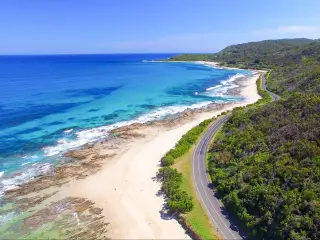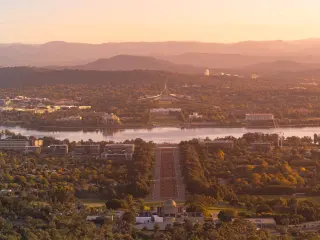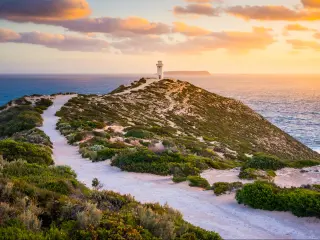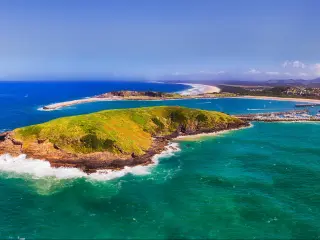Where is the Great Ocean Road Sign Located?
The Great Ocean Road is one of the world's most beautiful coastal drives, taking you past the famous Twelve Apostles, and travelling through sections of rainforest. For that reason, it's a hugely popular route for international visitors and Australians alike.
At the start of the Great Ocean Road, around 130 km out of Melbourne, you'll find the Memorial Arch which includes the historic Great Ocean Road Sign. It is easy to stop for a photo to immortalise your scenic journey on the Great Ocean Road.
While the Great Ocean Road itself is a memorial to fallen soldiers, the Memorial Arch recognises the thousands that came to Victoria to work on the road itself. Pull over when you reach the Great Ocean Road Sign to see the tributes built to mark anniversaries and to find out more about this spectacular feat of engineering.
Where is the Great Ocean Road Sign located?
The Great Ocean Road runs for 240 km between Torquay in the east and Allansford in the West. Along the way, it passes through Lorne, Apollo Bay, Great Otway National Park and Port Campbell.
In between the changing views of rugged rocky beaches, sweeping sandy bays and high clifftops, there are also stretches that run inland, winding through lush green forests of Melba Gully and Cape Otway.

You'll find the Great Ocean Road Sign on the Memorial Arch, located between Aireys Inlet and Lorne at the Melbourne end of the Great Ocean Road. Since the arch crosses the road itself, not only can you drive right up to it but if you're taking a trip along the Great Ocean Road, you'll drive under it.
Although the Great Ocean Road officially starts in nearby Torquay, this sign is a really popular place to stop for a photo to mark the start or end of your trip.
If you're interested in the history of the road, you'll also find information boards and a plaque beside the Great Ocean Road Sign where you can find out more.
The first Memorial Arch was constructed in the 1930s, not long after the Great Ocean Road was opened. Today's Memorial Arch is actually the fourth to stand on the site. The original arch was removed to make way for toll booths. One of its replacements was burnt down in a huge bush fire and another was hit by a truck.
Despite all these reconstructions, the Great Ocean Road Sign that hangs from the archway above the road is still the same one that travellers would have seen here in the 1930s.
How to drive up to the Great Ocean Road Sign
| Origin city | Distance | Driving Time |
|---|---|---|
| Torquay | 40 km | 35 minutes |
| Melbourne | 130 miles | 1 hour 50 minutes |
| Allansford | 210 miles | 3 hours 15 minutes |
| Warrnambool | 220 miles | 3 hours 25 minutes |
It's pretty simple to drive up to the Great Ocean Road sign on the Memorial Arch – if you're coming from the direction of Melbourne, you'll find it close to the start of the Great Ocean Road, and if you're heading towards Melbourne, it will be at the end of your trip.
This straightforward drive follows the B100 pretty much all the way, whether you're joining the Great Ocean Road in Torquay or Allansford. However, it's a very popular drive, especially during holiday periods and at weekends, so avoid these times if you'd prefer to see these spectacular natural monuments and beautiful beaches when the crowds are less.
If you're starting out in Melbourne and time is limited, you also have the option just to drive a shorter stretch of the Great Ocean Road once you've passed the Memorial Arch.
If you do decide to follow the whole route, or if you're heading to the Great Ocean Road Sign from Warrnambool, there are some charming small towns and beautiful beaches to stop at along the way.

Driving up to the Great Ocean Road Sign from Melbourne
The Memorial Arch is 130 km west of Melbourne, and it will take you around 1 hour 50 minutes to reach the Great Ocean Road Sign if you're starting in the center of the city.
It's a really simple route to navigate. Follow the M1 west out of Melbourne then, just south of Geelong, exit the motorway and follow signs to Torquay and the Great Ocean Road.
Once you reach Torquay, simply follow the well-signposted road in the direction of Warrnambool.
The Great Ocean Road travels through Anglesea and Aireys Inlet before following the long, sandy stretch of Fairhaven Beach. At the end of the beach, you'll arrive at the Great Ocean Road Sign. You can't miss the Memorial Arch - if you drive through the arch, you've gone too far!
Reaching the Great Ocean Road Sign from Warrnambool
You'll find the Great Ocean Road Sign at the end of your drive if you're starting at Warrnambool.
If you don't make any stops you can make the 220-km drive from Warrnambool to the Memorial Arch in around 3 hours 25 minutes. But seeing as almost all of the route is along the Great Ocean Road, we'd suggest allowing a lot longer so that you can really enjoy this scenic highway.
To get to the Great Ocean Road Sign Warrnambool, start out on the Princes Highway heading east out of the town then just after Allansford, where the Great Ocean Road begins, turn right towards Port Campbell.
From here, just follow the B100 through Mepunga and Peterborough. The next stretch of the road passes London Bridge on the way to Port Campbell, then you'll see Loch Ard Gorge and the Twelve Apostles before turning inland for a while towards Lavers Hill.
After crossing Cape Otway, you hit the ocean again. The road hugs the coast now, travelling through Apollo Bay, Sugarloaf and Lorne before reaching the Memorial Arch at the end of your Great Ocean Road Drive.
The Great Ocean Road Sign is marked on both sides of the Memorial Arch, so you'll spot it even if you're driving the route from west to east.
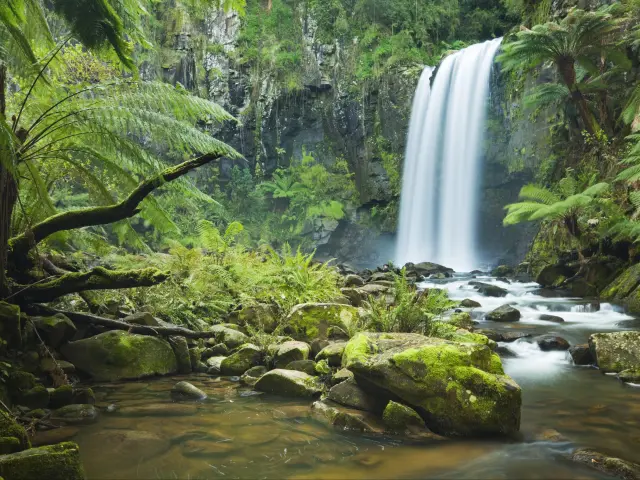
The best viewing spot for the Great Ocean Road Sign
The Great Ocean Road Sign is a really popular landmark, and you can walk right up to it for a better view. That means it's really simple to stop to take a photo of the Great Ocean Road Sign.
There's also a sculpture marking its 75th anniversary which is located off the road. You'll need to cross the road to take a photo of the older memorial plaque, just take your time and wait for a break in the traffic on busy days.
Can you park near the Great Ocean Road Sign
To make it even easier to stop and explore around the Great Ocean Road Sign, there's a free parking area right beside the Memorial Arch.
The Great Ocean Road is a 2-lane road (one lane in each direction) and the speed limit on this section is 80 km/h so it's not a difficult place to pull in and out of.
This is a popular stopping point so if you find the parking area is busy, why not pull in to one of the parking areas at nearby Eastern View and Sprout Creek and take the 600m walk along the beach?
Things you need to know about driving up to the Great Ocean Road Sign:
- The Memorial Arch and Great Ocean Road sign are close to the eastern end of the Great Ocean Road.
- It's not the official start point, but it's a very visual sign that your epic coastal drive is underway.
- Apart from navigating the Melbourne traffic, this is a straightforward drive.
- There are places to stop for food or drinks in nearby Anglesea, Aireys Inlet or Lorne, which are all just a few minutes' drive from the Memorial Arch itself.
- There's a parking area right by the Memorial Arch where you can stay for as long as you want while you read the information boards and enjoy the ocean view.
- You can easily get a photo beside the Memorial Arch. However, as it spans the Great Ocean Road itself we wouldn't recommend trying to get a picture right underneath it.
Things to see once you reach the Great Ocean Road Sign
Chances are you'll see the Great Ocean Road Sign at the start or end of this iconic coastal drive.
There are some great places to stop along the stretch nearest the sign itself, plus some must-see sights as you travel further along the Great Ocean Road.
- Aireys Inlet – The closest small town to the Memorial Arch offers a choice of places to eat or get a drink. You can also walk up to the apparently haunted Split Point Lighthouse and enjoy stunning views from the cliffs.
- Fairhaven Beach – This 6km-stretch of beach is the longest you'll see along the Great Ocean Road. Looking out towards the Bass Straight, it's part of Victoria's Surf Coast. There can be strong rip currents off the beach here so pay attention to local information to stay safe in the water.
- Erskine Falls – The rainforest scenery of the Otways is a real contrast to the ocean views along much of the rest of this route, and the short drive/walk combo to Erskine Falls, outside Lorne, is a great way to experience it.
- The Twelve Apostles – Further along the Great Ocean Road you'll reach these seven famous rock stacks (the eighth was lost to the sea nearly 20 years ago), which rise up out of the ocean. Admire them from all angles with a hike down to the beach or splash out on a helicopter flight.

Popular stops along the Great Ocean Road – especially the famous Twelve Apostles – can get really busy as the day goes on, so consider visiting early in the morning. The light is beautiful at this time of day, so you'll be rewarded with spectacular photographs.
Although on paper you can drive the road from end to end in around 3 hours, you'll probably want to add at least 3 hours more to give time to enjoy the places you'll see along the way. Don't forget to allow time for the return drive to Melbourne too.



